E-Commerce Business Skills: Burton's Structural Framework & Objectives
VerifiedAdded on 2023/04/07
|21
|6361
|459
Report
AI Summary
This report provides a comprehensive analysis of Burton, a UK-based retail clothing organization, focusing on its e-commerce business skills, structural framework, and organizational objectives. It evaluates the core business functions, including marketing, sales, HR, finance, and MIS, within a hierarchical organizational structure. The report also examines Burton's objectives, such as profit maximization and market share retention, through a PEST analysis, considering political and economic factors. Furthermore, it assesses the impact of e-commerce on consumers and businesses, investigates market potential for e-commerce opportunities, and evaluates e-commerce systems used by various organizations. The report concludes with a proposed e-commerce solution for Burton and an evaluation of its sustainability.
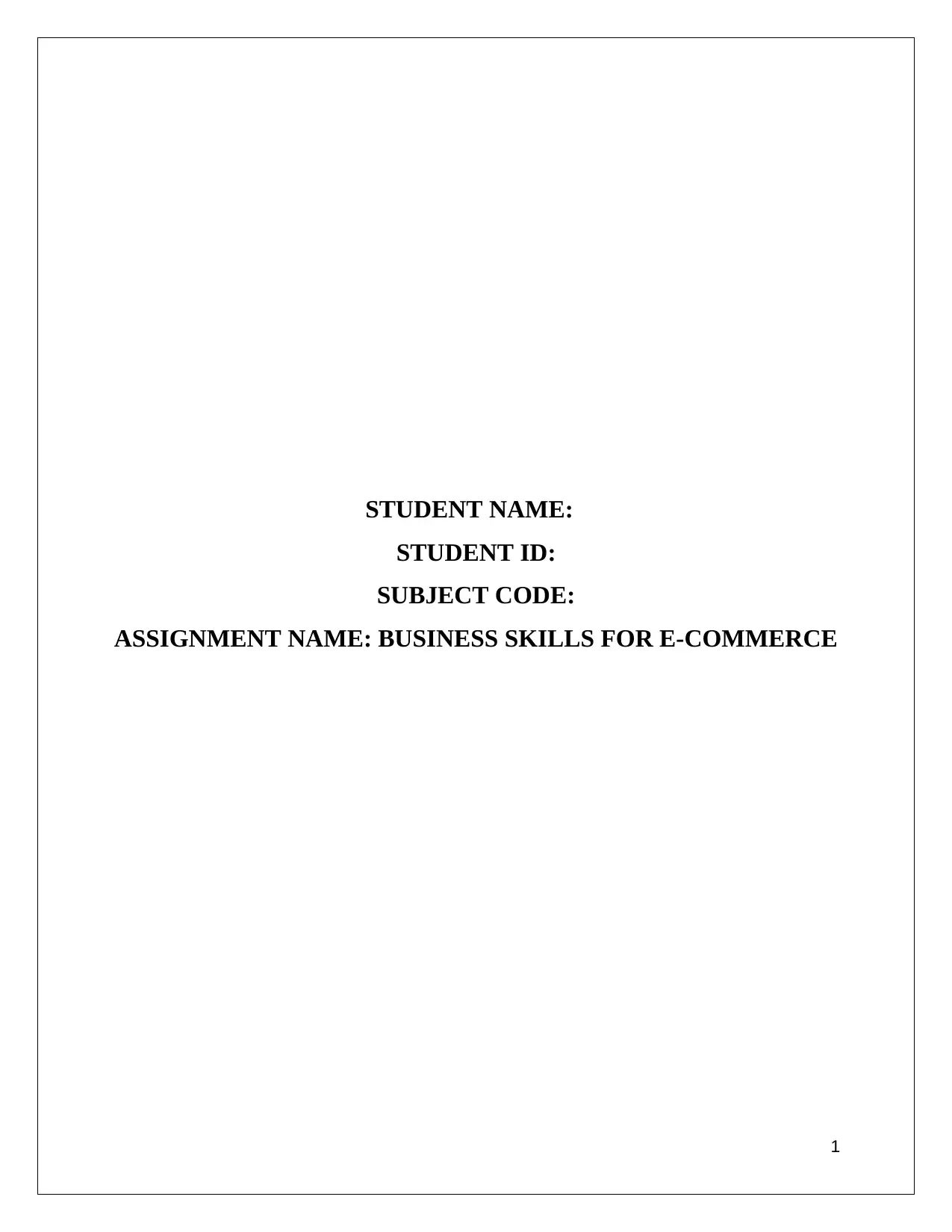
STUDENT NAME:
STUDENT ID:
SUBJECT CODE:
ASSIGNMENT NAME: BUSINESS SKILLS FOR E-COMMERCE
1
STUDENT ID:
SUBJECT CODE:
ASSIGNMENT NAME: BUSINESS SKILLS FOR E-COMMERCE
1
Paraphrase This Document
Need a fresh take? Get an instant paraphrase of this document with our AI Paraphraser
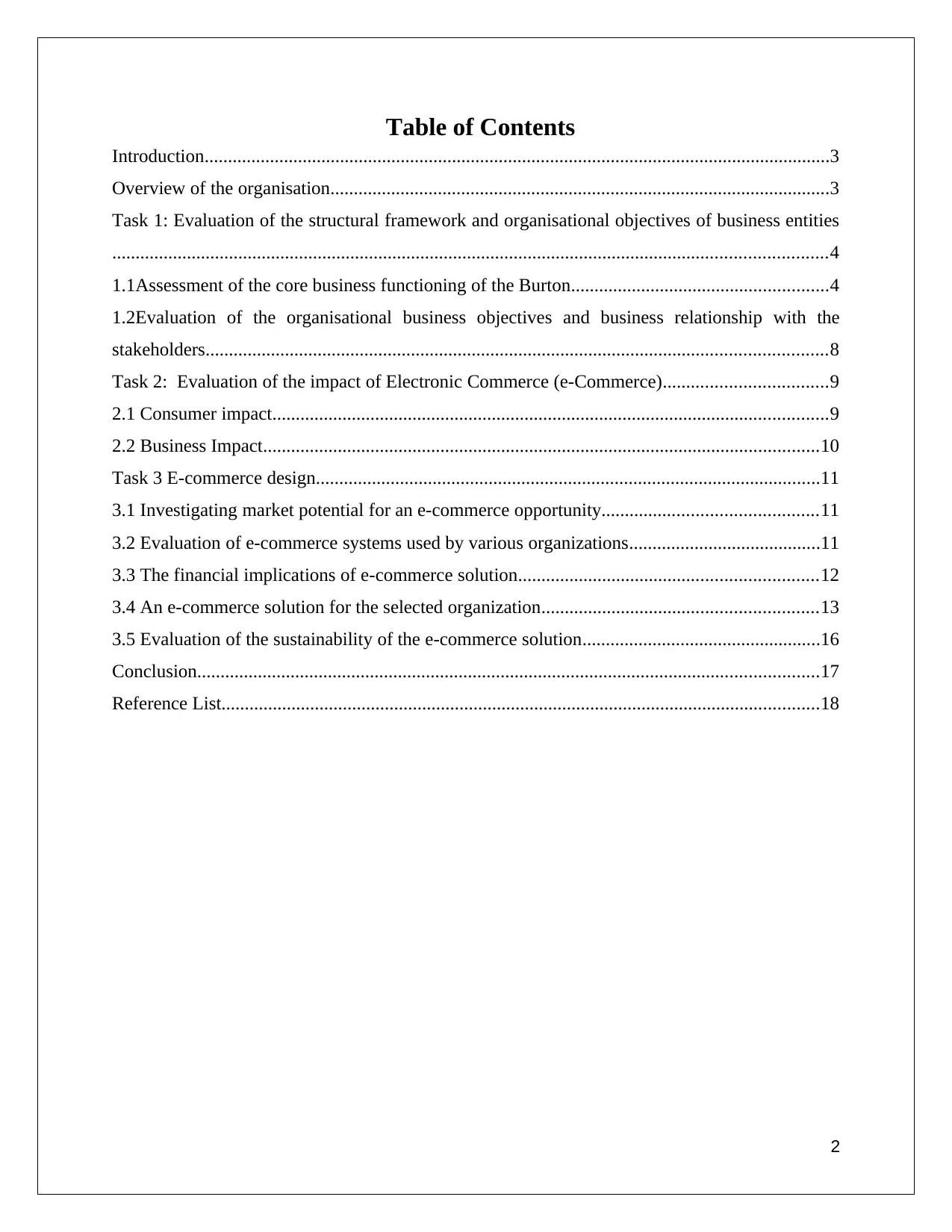
Table of Contents
Introduction......................................................................................................................................3
Overview of the organisation...........................................................................................................3
Task 1: Evaluation of the structural framework and organisational objectives of business entities
.........................................................................................................................................................4
1.1Assessment of the core business functioning of the Burton.......................................................4
1.2Evaluation of the organisational business objectives and business relationship with the
stakeholders.....................................................................................................................................8
Task 2: Evaluation of the impact of Electronic Commerce (e-Commerce)...................................9
2.1 Consumer impact.......................................................................................................................9
2.2 Business Impact.......................................................................................................................10
Task 3 E-commerce design............................................................................................................11
3.1 Investigating market potential for an e-commerce opportunity..............................................11
3.2 Evaluation of e-commerce systems used by various organizations.........................................11
3.3 The financial implications of e-commerce solution................................................................12
3.4 An e-commerce solution for the selected organization...........................................................13
3.5 Evaluation of the sustainability of the e-commerce solution...................................................16
Conclusion.....................................................................................................................................17
Reference List................................................................................................................................18
2
Introduction......................................................................................................................................3
Overview of the organisation...........................................................................................................3
Task 1: Evaluation of the structural framework and organisational objectives of business entities
.........................................................................................................................................................4
1.1Assessment of the core business functioning of the Burton.......................................................4
1.2Evaluation of the organisational business objectives and business relationship with the
stakeholders.....................................................................................................................................8
Task 2: Evaluation of the impact of Electronic Commerce (e-Commerce)...................................9
2.1 Consumer impact.......................................................................................................................9
2.2 Business Impact.......................................................................................................................10
Task 3 E-commerce design............................................................................................................11
3.1 Investigating market potential for an e-commerce opportunity..............................................11
3.2 Evaluation of e-commerce systems used by various organizations.........................................11
3.3 The financial implications of e-commerce solution................................................................12
3.4 An e-commerce solution for the selected organization...........................................................13
3.5 Evaluation of the sustainability of the e-commerce solution...................................................16
Conclusion.....................................................................................................................................17
Reference List................................................................................................................................18
2
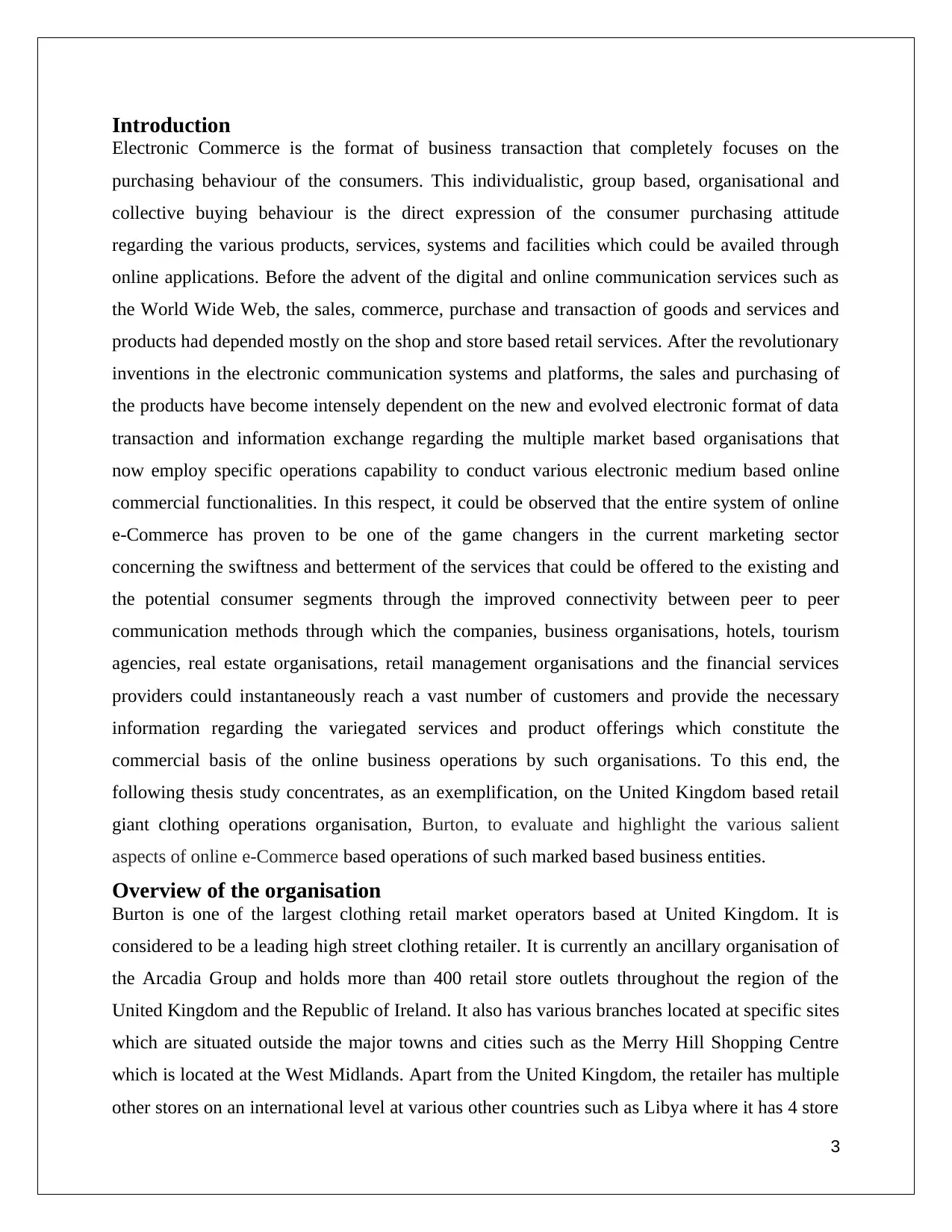
Introduction
Electronic Commerce is the format of business transaction that completely focuses on the
purchasing behaviour of the consumers. This individualistic, group based, organisational and
collective buying behaviour is the direct expression of the consumer purchasing attitude
regarding the various products, services, systems and facilities which could be availed through
online applications. Before the advent of the digital and online communication services such as
the World Wide Web, the sales, commerce, purchase and transaction of goods and services and
products had depended mostly on the shop and store based retail services. After the revolutionary
inventions in the electronic communication systems and platforms, the sales and purchasing of
the products have become intensely dependent on the new and evolved electronic format of data
transaction and information exchange regarding the multiple market based organisations that
now employ specific operations capability to conduct various electronic medium based online
commercial functionalities. In this respect, it could be observed that the entire system of online
e-Commerce has proven to be one of the game changers in the current marketing sector
concerning the swiftness and betterment of the services that could be offered to the existing and
the potential consumer segments through the improved connectivity between peer to peer
communication methods through which the companies, business organisations, hotels, tourism
agencies, real estate organisations, retail management organisations and the financial services
providers could instantaneously reach a vast number of customers and provide the necessary
information regarding the variegated services and product offerings which constitute the
commercial basis of the online business operations by such organisations. To this end, the
following thesis study concentrates, as an exemplification, on the United Kingdom based retail
giant clothing operations organisation, Burton, to evaluate and highlight the various salient
aspects of online e-Commerce based operations of such marked based business entities.
Overview of the organisation
Burton is one of the largest clothing retail market operators based at United Kingdom. It is
considered to be a leading high street clothing retailer. It is currently an ancillary organisation of
the Arcadia Group and holds more than 400 retail store outlets throughout the region of the
United Kingdom and the Republic of Ireland. It also has various branches located at specific sites
which are situated outside the major towns and cities such as the Merry Hill Shopping Centre
which is located at the West Midlands. Apart from the United Kingdom, the retailer has multiple
other stores on an international level at various other countries such as Libya where it has 4 store
3
Electronic Commerce is the format of business transaction that completely focuses on the
purchasing behaviour of the consumers. This individualistic, group based, organisational and
collective buying behaviour is the direct expression of the consumer purchasing attitude
regarding the various products, services, systems and facilities which could be availed through
online applications. Before the advent of the digital and online communication services such as
the World Wide Web, the sales, commerce, purchase and transaction of goods and services and
products had depended mostly on the shop and store based retail services. After the revolutionary
inventions in the electronic communication systems and platforms, the sales and purchasing of
the products have become intensely dependent on the new and evolved electronic format of data
transaction and information exchange regarding the multiple market based organisations that
now employ specific operations capability to conduct various electronic medium based online
commercial functionalities. In this respect, it could be observed that the entire system of online
e-Commerce has proven to be one of the game changers in the current marketing sector
concerning the swiftness and betterment of the services that could be offered to the existing and
the potential consumer segments through the improved connectivity between peer to peer
communication methods through which the companies, business organisations, hotels, tourism
agencies, real estate organisations, retail management organisations and the financial services
providers could instantaneously reach a vast number of customers and provide the necessary
information regarding the variegated services and product offerings which constitute the
commercial basis of the online business operations by such organisations. To this end, the
following thesis study concentrates, as an exemplification, on the United Kingdom based retail
giant clothing operations organisation, Burton, to evaluate and highlight the various salient
aspects of online e-Commerce based operations of such marked based business entities.
Overview of the organisation
Burton is one of the largest clothing retail market operators based at United Kingdom. It is
considered to be a leading high street clothing retailer. It is currently an ancillary organisation of
the Arcadia Group and holds more than 400 retail store outlets throughout the region of the
United Kingdom and the Republic of Ireland. It also has various branches located at specific sites
which are situated outside the major towns and cities such as the Merry Hill Shopping Centre
which is located at the West Midlands. Apart from the United Kingdom, the retailer has multiple
other stores on an international level at various other countries such as Libya where it has 4 store
3
⊘ This is a preview!⊘
Do you want full access?
Subscribe today to unlock all pages.

Trusted by 1+ million students worldwide
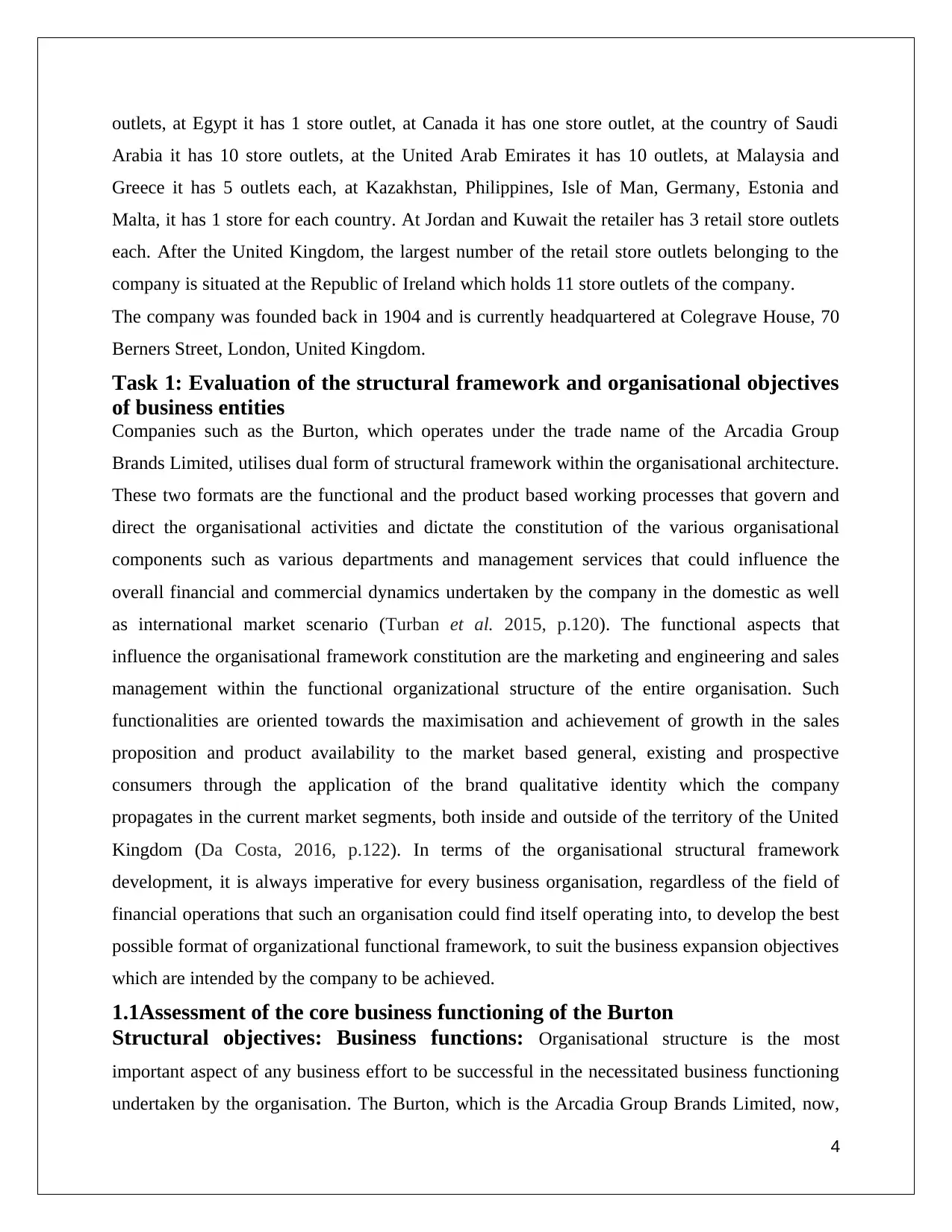
outlets, at Egypt it has 1 store outlet, at Canada it has one store outlet, at the country of Saudi
Arabia it has 10 store outlets, at the United Arab Emirates it has 10 outlets, at Malaysia and
Greece it has 5 outlets each, at Kazakhstan, Philippines, Isle of Man, Germany, Estonia and
Malta, it has 1 store for each country. At Jordan and Kuwait the retailer has 3 retail store outlets
each. After the United Kingdom, the largest number of the retail store outlets belonging to the
company is situated at the Republic of Ireland which holds 11 store outlets of the company.
The company was founded back in 1904 and is currently headquartered at Colegrave House, 70
Berners Street, London, United Kingdom.
Task 1: Evaluation of the structural framework and organisational objectives
of business entities
Companies such as the Burton, which operates under the trade name of the Arcadia Group
Brands Limited, utilises dual form of structural framework within the organisational architecture.
These two formats are the functional and the product based working processes that govern and
direct the organisational activities and dictate the constitution of the various organisational
components such as various departments and management services that could influence the
overall financial and commercial dynamics undertaken by the company in the domestic as well
as international market scenario (Turban et al. 2015, p.120). The functional aspects that
influence the organisational framework constitution are the marketing and engineering and sales
management within the functional organizational structure of the entire organisation. Such
functionalities are oriented towards the maximisation and achievement of growth in the sales
proposition and product availability to the market based general, existing and prospective
consumers through the application of the brand qualitative identity which the company
propagates in the current market segments, both inside and outside of the territory of the United
Kingdom (Da Costa, 2016, p.122). In terms of the organisational structural framework
development, it is always imperative for every business organisation, regardless of the field of
financial operations that such an organisation could find itself operating into, to develop the best
possible format of organizational functional framework, to suit the business expansion objectives
which are intended by the company to be achieved.
1.1Assessment of the core business functioning of the Burton
Structural objectives: Business functions: Organisational structure is the most
important aspect of any business effort to be successful in the necessitated business functioning
undertaken by the organisation. The Burton, which is the Arcadia Group Brands Limited, now,
4
Arabia it has 10 store outlets, at the United Arab Emirates it has 10 outlets, at Malaysia and
Greece it has 5 outlets each, at Kazakhstan, Philippines, Isle of Man, Germany, Estonia and
Malta, it has 1 store for each country. At Jordan and Kuwait the retailer has 3 retail store outlets
each. After the United Kingdom, the largest number of the retail store outlets belonging to the
company is situated at the Republic of Ireland which holds 11 store outlets of the company.
The company was founded back in 1904 and is currently headquartered at Colegrave House, 70
Berners Street, London, United Kingdom.
Task 1: Evaluation of the structural framework and organisational objectives
of business entities
Companies such as the Burton, which operates under the trade name of the Arcadia Group
Brands Limited, utilises dual form of structural framework within the organisational architecture.
These two formats are the functional and the product based working processes that govern and
direct the organisational activities and dictate the constitution of the various organisational
components such as various departments and management services that could influence the
overall financial and commercial dynamics undertaken by the company in the domestic as well
as international market scenario (Turban et al. 2015, p.120). The functional aspects that
influence the organisational framework constitution are the marketing and engineering and sales
management within the functional organizational structure of the entire organisation. Such
functionalities are oriented towards the maximisation and achievement of growth in the sales
proposition and product availability to the market based general, existing and prospective
consumers through the application of the brand qualitative identity which the company
propagates in the current market segments, both inside and outside of the territory of the United
Kingdom (Da Costa, 2016, p.122). In terms of the organisational structural framework
development, it is always imperative for every business organisation, regardless of the field of
financial operations that such an organisation could find itself operating into, to develop the best
possible format of organizational functional framework, to suit the business expansion objectives
which are intended by the company to be achieved.
1.1Assessment of the core business functioning of the Burton
Structural objectives: Business functions: Organisational structure is the most
important aspect of any business effort to be successful in the necessitated business functioning
undertaken by the organisation. The Burton, which is the Arcadia Group Brands Limited, now,
4
Paraphrase This Document
Need a fresh take? Get an instant paraphrase of this document with our AI Paraphraser
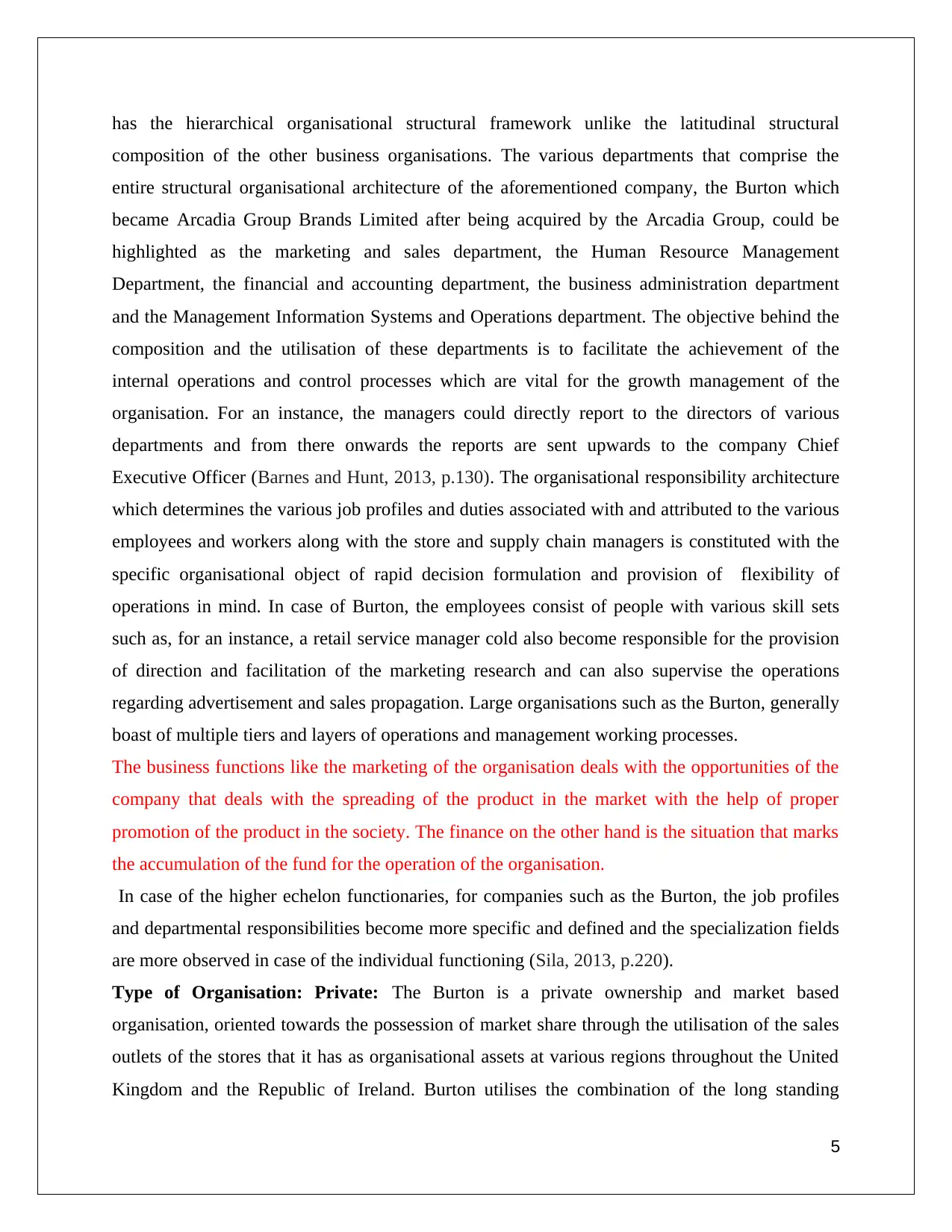
has the hierarchical organisational structural framework unlike the latitudinal structural
composition of the other business organisations. The various departments that comprise the
entire structural organisational architecture of the aforementioned company, the Burton which
became Arcadia Group Brands Limited after being acquired by the Arcadia Group, could be
highlighted as the marketing and sales department, the Human Resource Management
Department, the financial and accounting department, the business administration department
and the Management Information Systems and Operations department. The objective behind the
composition and the utilisation of these departments is to facilitate the achievement of the
internal operations and control processes which are vital for the growth management of the
organisation. For an instance, the managers could directly report to the directors of various
departments and from there onwards the reports are sent upwards to the company Chief
Executive Officer (Barnes and Hunt, 2013, p.130). The organisational responsibility architecture
which determines the various job profiles and duties associated with and attributed to the various
employees and workers along with the store and supply chain managers is constituted with the
specific organisational object of rapid decision formulation and provision of flexibility of
operations in mind. In case of Burton, the employees consist of people with various skill sets
such as, for an instance, a retail service manager cold also become responsible for the provision
of direction and facilitation of the marketing research and can also supervise the operations
regarding advertisement and sales propagation. Large organisations such as the Burton, generally
boast of multiple tiers and layers of operations and management working processes.
The business functions like the marketing of the organisation deals with the opportunities of the
company that deals with the spreading of the product in the market with the help of proper
promotion of the product in the society. The finance on the other hand is the situation that marks
the accumulation of the fund for the operation of the organisation.
In case of the higher echelon functionaries, for companies such as the Burton, the job profiles
and departmental responsibilities become more specific and defined and the specialization fields
are more observed in case of the individual functioning (Sila, 2013, p.220).
Type of Organisation: Private: The Burton is a private ownership and market based
organisation, oriented towards the possession of market share through the utilisation of the sales
outlets of the stores that it has as organisational assets at various regions throughout the United
Kingdom and the Republic of Ireland. Burton utilises the combination of the long standing
5
composition of the other business organisations. The various departments that comprise the
entire structural organisational architecture of the aforementioned company, the Burton which
became Arcadia Group Brands Limited after being acquired by the Arcadia Group, could be
highlighted as the marketing and sales department, the Human Resource Management
Department, the financial and accounting department, the business administration department
and the Management Information Systems and Operations department. The objective behind the
composition and the utilisation of these departments is to facilitate the achievement of the
internal operations and control processes which are vital for the growth management of the
organisation. For an instance, the managers could directly report to the directors of various
departments and from there onwards the reports are sent upwards to the company Chief
Executive Officer (Barnes and Hunt, 2013, p.130). The organisational responsibility architecture
which determines the various job profiles and duties associated with and attributed to the various
employees and workers along with the store and supply chain managers is constituted with the
specific organisational object of rapid decision formulation and provision of flexibility of
operations in mind. In case of Burton, the employees consist of people with various skill sets
such as, for an instance, a retail service manager cold also become responsible for the provision
of direction and facilitation of the marketing research and can also supervise the operations
regarding advertisement and sales propagation. Large organisations such as the Burton, generally
boast of multiple tiers and layers of operations and management working processes.
The business functions like the marketing of the organisation deals with the opportunities of the
company that deals with the spreading of the product in the market with the help of proper
promotion of the product in the society. The finance on the other hand is the situation that marks
the accumulation of the fund for the operation of the organisation.
In case of the higher echelon functionaries, for companies such as the Burton, the job profiles
and departmental responsibilities become more specific and defined and the specialization fields
are more observed in case of the individual functioning (Sila, 2013, p.220).
Type of Organisation: Private: The Burton is a private ownership and market based
organisation, oriented towards the possession of market share through the utilisation of the sales
outlets of the stores that it has as organisational assets at various regions throughout the United
Kingdom and the Republic of Ireland. Burton utilises the combination of the long standing
5
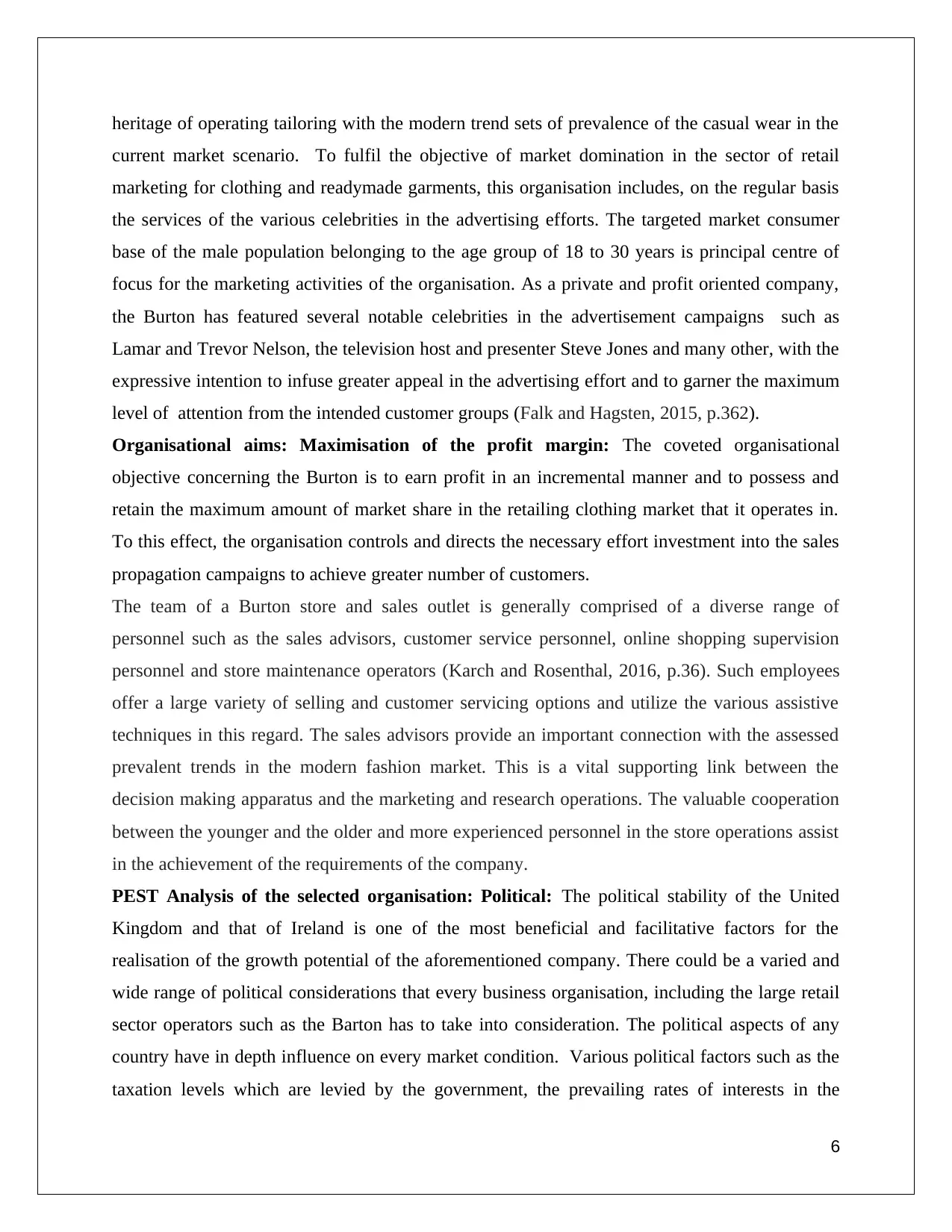
heritage of operating tailoring with the modern trend sets of prevalence of the casual wear in the
current market scenario. To fulfil the objective of market domination in the sector of retail
marketing for clothing and readymade garments, this organisation includes, on the regular basis
the services of the various celebrities in the advertising efforts. The targeted market consumer
base of the male population belonging to the age group of 18 to 30 years is principal centre of
focus for the marketing activities of the organisation. As a private and profit oriented company,
the Burton has featured several notable celebrities in the advertisement campaigns such as
Lamar and Trevor Nelson, the television host and presenter Steve Jones and many other, with the
expressive intention to infuse greater appeal in the advertising effort and to garner the maximum
level of attention from the intended customer groups (Falk and Hagsten, 2015, p.362).
Organisational aims: Maximisation of the profit margin: The coveted organisational
objective concerning the Burton is to earn profit in an incremental manner and to possess and
retain the maximum amount of market share in the retailing clothing market that it operates in.
To this effect, the organisation controls and directs the necessary effort investment into the sales
propagation campaigns to achieve greater number of customers.
The team of a Burton store and sales outlet is generally comprised of a diverse range of
personnel such as the sales advisors, customer service personnel, online shopping supervision
personnel and store maintenance operators (Karch and Rosenthal, 2016, p.36). Such employees
offer a large variety of selling and customer servicing options and utilize the various assistive
techniques in this regard. The sales advisors provide an important connection with the assessed
prevalent trends in the modern fashion market. This is a vital supporting link between the
decision making apparatus and the marketing and research operations. The valuable cooperation
between the younger and the older and more experienced personnel in the store operations assist
in the achievement of the requirements of the company.
PEST Analysis of the selected organisation: Political: The political stability of the United
Kingdom and that of Ireland is one of the most beneficial and facilitative factors for the
realisation of the growth potential of the aforementioned company. There could be a varied and
wide range of political considerations that every business organisation, including the large retail
sector operators such as the Barton has to take into consideration. The political aspects of any
country have in depth influence on every market condition. Various political factors such as the
taxation levels which are levied by the government, the prevailing rates of interests in the
6
current market scenario. To fulfil the objective of market domination in the sector of retail
marketing for clothing and readymade garments, this organisation includes, on the regular basis
the services of the various celebrities in the advertising efforts. The targeted market consumer
base of the male population belonging to the age group of 18 to 30 years is principal centre of
focus for the marketing activities of the organisation. As a private and profit oriented company,
the Burton has featured several notable celebrities in the advertisement campaigns such as
Lamar and Trevor Nelson, the television host and presenter Steve Jones and many other, with the
expressive intention to infuse greater appeal in the advertising effort and to garner the maximum
level of attention from the intended customer groups (Falk and Hagsten, 2015, p.362).
Organisational aims: Maximisation of the profit margin: The coveted organisational
objective concerning the Burton is to earn profit in an incremental manner and to possess and
retain the maximum amount of market share in the retailing clothing market that it operates in.
To this effect, the organisation controls and directs the necessary effort investment into the sales
propagation campaigns to achieve greater number of customers.
The team of a Burton store and sales outlet is generally comprised of a diverse range of
personnel such as the sales advisors, customer service personnel, online shopping supervision
personnel and store maintenance operators (Karch and Rosenthal, 2016, p.36). Such employees
offer a large variety of selling and customer servicing options and utilize the various assistive
techniques in this regard. The sales advisors provide an important connection with the assessed
prevalent trends in the modern fashion market. This is a vital supporting link between the
decision making apparatus and the marketing and research operations. The valuable cooperation
between the younger and the older and more experienced personnel in the store operations assist
in the achievement of the requirements of the company.
PEST Analysis of the selected organisation: Political: The political stability of the United
Kingdom and that of Ireland is one of the most beneficial and facilitative factors for the
realisation of the growth potential of the aforementioned company. There could be a varied and
wide range of political considerations that every business organisation, including the large retail
sector operators such as the Barton has to take into consideration. The political aspects of any
country have in depth influence on every market condition. Various political factors such as the
taxation levels which are levied by the government, the prevailing rates of interests in the
6
⊘ This is a preview!⊘
Do you want full access?
Subscribe today to unlock all pages.

Trusted by 1+ million students worldwide
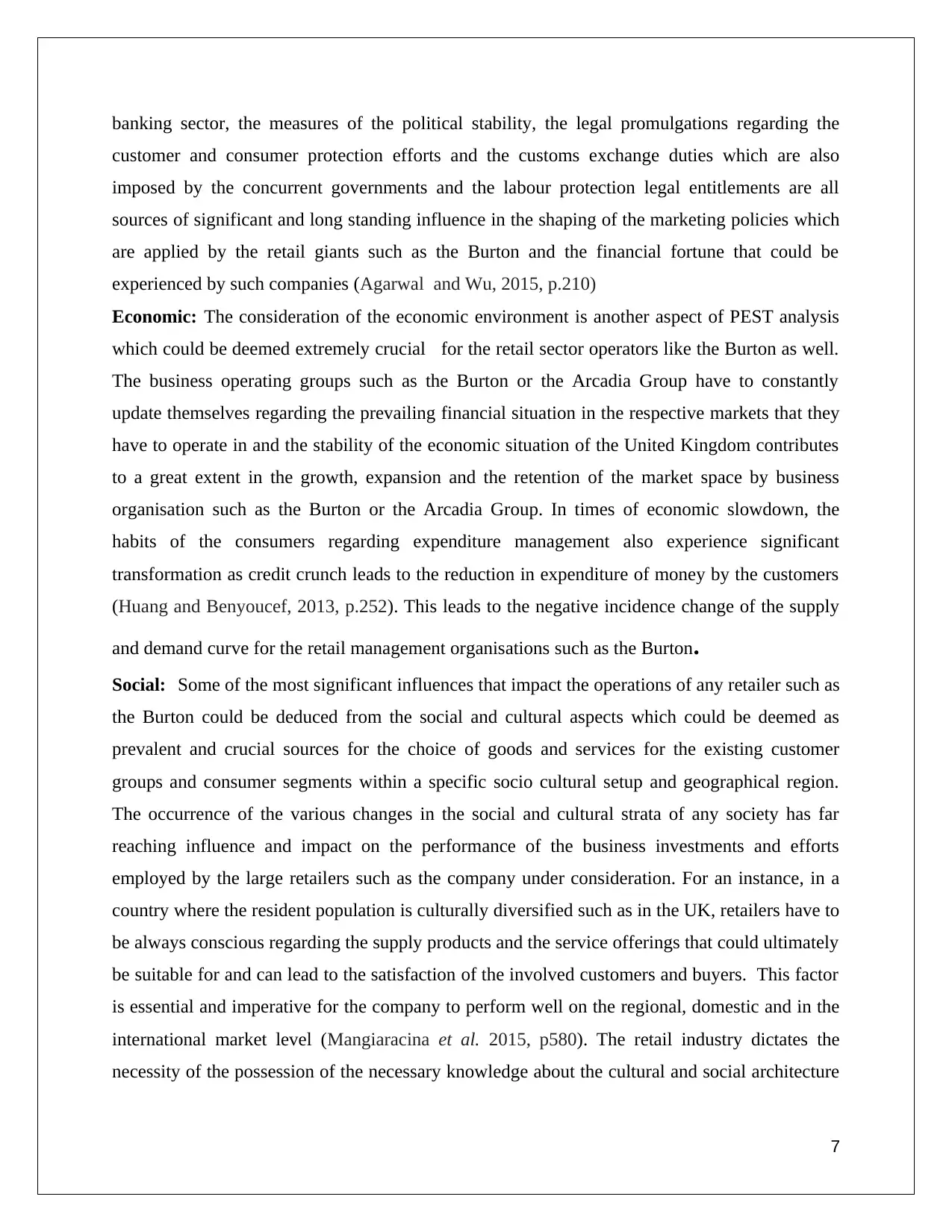
banking sector, the measures of the political stability, the legal promulgations regarding the
customer and consumer protection efforts and the customs exchange duties which are also
imposed by the concurrent governments and the labour protection legal entitlements are all
sources of significant and long standing influence in the shaping of the marketing policies which
are applied by the retail giants such as the Burton and the financial fortune that could be
experienced by such companies (Agarwal and Wu, 2015, p.210)
Economic: The consideration of the economic environment is another aspect of PEST analysis
which could be deemed extremely crucial for the retail sector operators like the Burton as well.
The business operating groups such as the Burton or the Arcadia Group have to constantly
update themselves regarding the prevailing financial situation in the respective markets that they
have to operate in and the stability of the economic situation of the United Kingdom contributes
to a great extent in the growth, expansion and the retention of the market space by business
organisation such as the Burton or the Arcadia Group. In times of economic slowdown, the
habits of the consumers regarding expenditure management also experience significant
transformation as credit crunch leads to the reduction in expenditure of money by the customers
(Huang and Benyoucef, 2013, p.252). This leads to the negative incidence change of the supply
and demand curve for the retail management organisations such as the Burton.
Social: Some of the most significant influences that impact the operations of any retailer such as
the Burton could be deduced from the social and cultural aspects which could be deemed as
prevalent and crucial sources for the choice of goods and services for the existing customer
groups and consumer segments within a specific socio cultural setup and geographical region.
The occurrence of the various changes in the social and cultural strata of any society has far
reaching influence and impact on the performance of the business investments and efforts
employed by the large retailers such as the company under consideration. For an instance, in a
country where the resident population is culturally diversified such as in the UK, retailers have to
be always conscious regarding the supply products and the service offerings that could ultimately
be suitable for and can lead to the satisfaction of the involved customers and buyers. This factor
is essential and imperative for the company to perform well on the regional, domestic and in the
international market level (Mangiaracina et al. 2015, p580). The retail industry dictates the
necessity of the possession of the necessary knowledge about the cultural and social architecture
7
customer and consumer protection efforts and the customs exchange duties which are also
imposed by the concurrent governments and the labour protection legal entitlements are all
sources of significant and long standing influence in the shaping of the marketing policies which
are applied by the retail giants such as the Burton and the financial fortune that could be
experienced by such companies (Agarwal and Wu, 2015, p.210)
Economic: The consideration of the economic environment is another aspect of PEST analysis
which could be deemed extremely crucial for the retail sector operators like the Burton as well.
The business operating groups such as the Burton or the Arcadia Group have to constantly
update themselves regarding the prevailing financial situation in the respective markets that they
have to operate in and the stability of the economic situation of the United Kingdom contributes
to a great extent in the growth, expansion and the retention of the market space by business
organisation such as the Burton or the Arcadia Group. In times of economic slowdown, the
habits of the consumers regarding expenditure management also experience significant
transformation as credit crunch leads to the reduction in expenditure of money by the customers
(Huang and Benyoucef, 2013, p.252). This leads to the negative incidence change of the supply
and demand curve for the retail management organisations such as the Burton.
Social: Some of the most significant influences that impact the operations of any retailer such as
the Burton could be deduced from the social and cultural aspects which could be deemed as
prevalent and crucial sources for the choice of goods and services for the existing customer
groups and consumer segments within a specific socio cultural setup and geographical region.
The occurrence of the various changes in the social and cultural strata of any society has far
reaching influence and impact on the performance of the business investments and efforts
employed by the large retailers such as the company under consideration. For an instance, in a
country where the resident population is culturally diversified such as in the UK, retailers have to
be always conscious regarding the supply products and the service offerings that could ultimately
be suitable for and can lead to the satisfaction of the involved customers and buyers. This factor
is essential and imperative for the company to perform well on the regional, domestic and in the
international market level (Mangiaracina et al. 2015, p580). The retail industry dictates the
necessity of the possession of the necessary knowledge about the cultural and social architecture
7
Paraphrase This Document
Need a fresh take? Get an instant paraphrase of this document with our AI Paraphraser
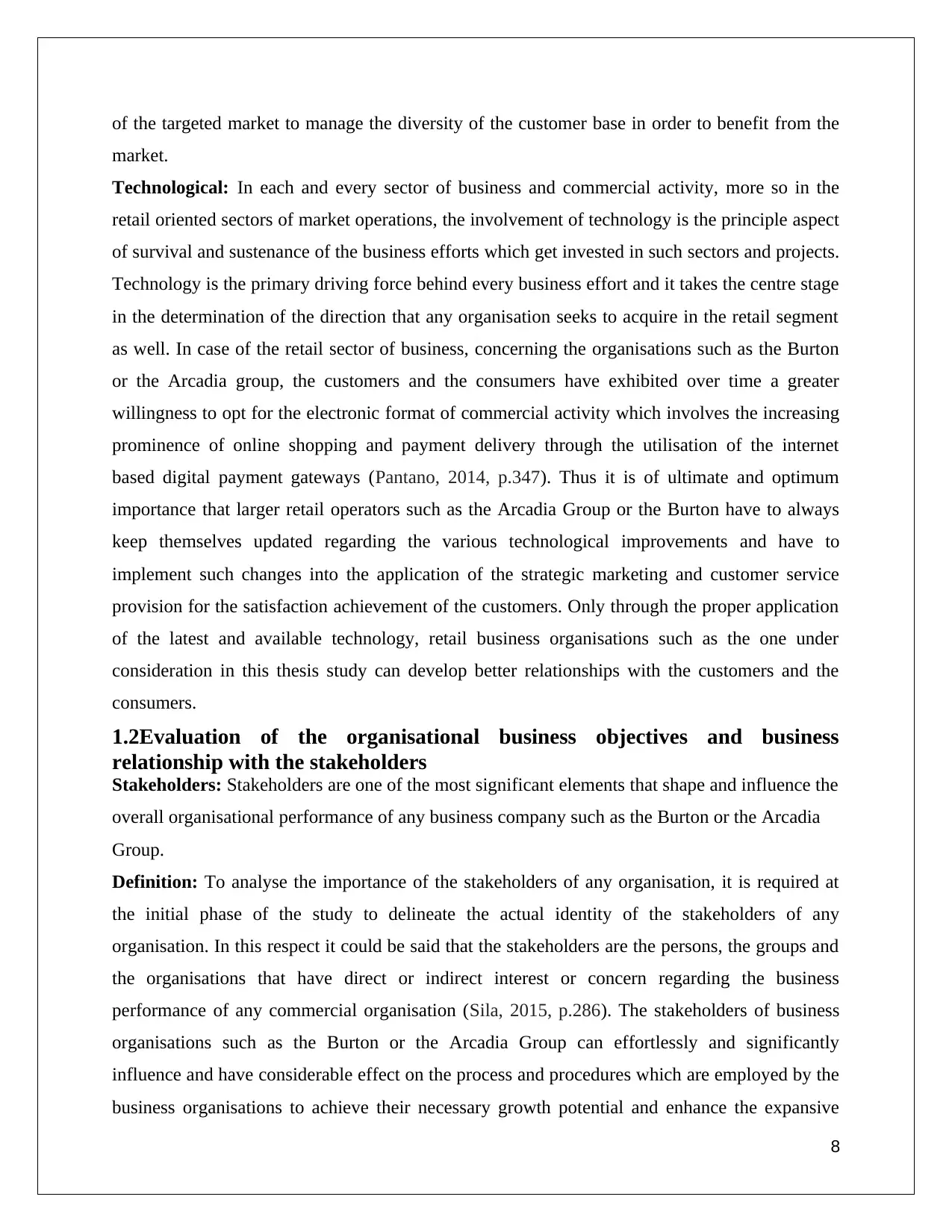
of the targeted market to manage the diversity of the customer base in order to benefit from the
market.
Technological: In each and every sector of business and commercial activity, more so in the
retail oriented sectors of market operations, the involvement of technology is the principle aspect
of survival and sustenance of the business efforts which get invested in such sectors and projects.
Technology is the primary driving force behind every business effort and it takes the centre stage
in the determination of the direction that any organisation seeks to acquire in the retail segment
as well. In case of the retail sector of business, concerning the organisations such as the Burton
or the Arcadia group, the customers and the consumers have exhibited over time a greater
willingness to opt for the electronic format of commercial activity which involves the increasing
prominence of online shopping and payment delivery through the utilisation of the internet
based digital payment gateways (Pantano, 2014, p.347). Thus it is of ultimate and optimum
importance that larger retail operators such as the Arcadia Group or the Burton have to always
keep themselves updated regarding the various technological improvements and have to
implement such changes into the application of the strategic marketing and customer service
provision for the satisfaction achievement of the customers. Only through the proper application
of the latest and available technology, retail business organisations such as the one under
consideration in this thesis study can develop better relationships with the customers and the
consumers.
1.2Evaluation of the organisational business objectives and business
relationship with the stakeholders
Stakeholders: Stakeholders are one of the most significant elements that shape and influence the
overall organisational performance of any business company such as the Burton or the Arcadia
Group.
Definition: To analyse the importance of the stakeholders of any organisation, it is required at
the initial phase of the study to delineate the actual identity of the stakeholders of any
organisation. In this respect it could be said that the stakeholders are the persons, the groups and
the organisations that have direct or indirect interest or concern regarding the business
performance of any commercial organisation (Sila, 2015, p.286). The stakeholders of business
organisations such as the Burton or the Arcadia Group can effortlessly and significantly
influence and have considerable effect on the process and procedures which are employed by the
business organisations to achieve their necessary growth potential and enhance the expansive
8
market.
Technological: In each and every sector of business and commercial activity, more so in the
retail oriented sectors of market operations, the involvement of technology is the principle aspect
of survival and sustenance of the business efforts which get invested in such sectors and projects.
Technology is the primary driving force behind every business effort and it takes the centre stage
in the determination of the direction that any organisation seeks to acquire in the retail segment
as well. In case of the retail sector of business, concerning the organisations such as the Burton
or the Arcadia group, the customers and the consumers have exhibited over time a greater
willingness to opt for the electronic format of commercial activity which involves the increasing
prominence of online shopping and payment delivery through the utilisation of the internet
based digital payment gateways (Pantano, 2014, p.347). Thus it is of ultimate and optimum
importance that larger retail operators such as the Arcadia Group or the Burton have to always
keep themselves updated regarding the various technological improvements and have to
implement such changes into the application of the strategic marketing and customer service
provision for the satisfaction achievement of the customers. Only through the proper application
of the latest and available technology, retail business organisations such as the one under
consideration in this thesis study can develop better relationships with the customers and the
consumers.
1.2Evaluation of the organisational business objectives and business
relationship with the stakeholders
Stakeholders: Stakeholders are one of the most significant elements that shape and influence the
overall organisational performance of any business company such as the Burton or the Arcadia
Group.
Definition: To analyse the importance of the stakeholders of any organisation, it is required at
the initial phase of the study to delineate the actual identity of the stakeholders of any
organisation. In this respect it could be said that the stakeholders are the persons, the groups and
the organisations that have direct or indirect interest or concern regarding the business
performance of any commercial organisation (Sila, 2015, p.286). The stakeholders of business
organisations such as the Burton or the Arcadia Group can effortlessly and significantly
influence and have considerable effect on the process and procedures which are employed by the
business organisations to achieve their necessary growth potential and enhance the expansive
8
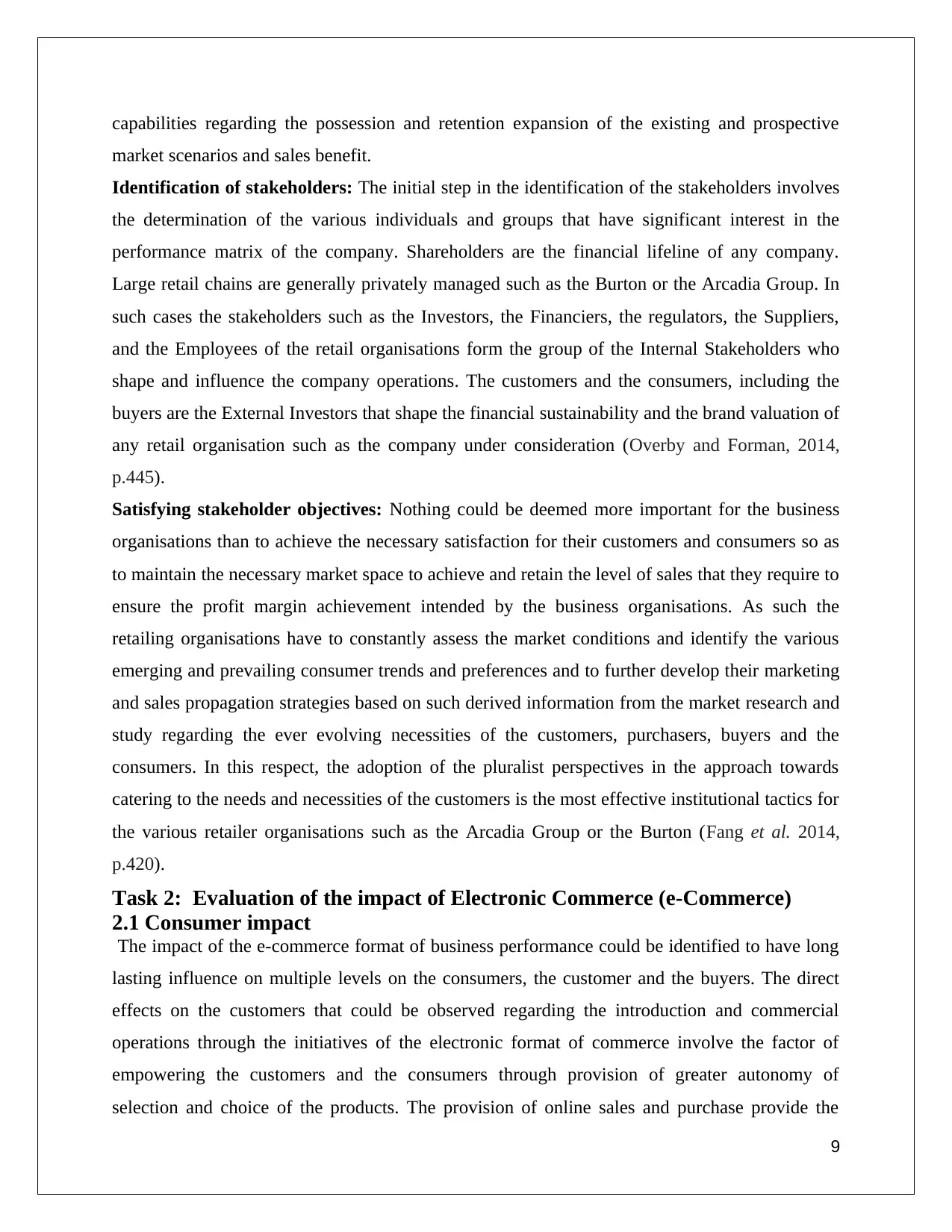
capabilities regarding the possession and retention expansion of the existing and prospective
market scenarios and sales benefit.
Identification of stakeholders: The initial step in the identification of the stakeholders involves
the determination of the various individuals and groups that have significant interest in the
performance matrix of the company. Shareholders are the financial lifeline of any company.
Large retail chains are generally privately managed such as the Burton or the Arcadia Group. In
such cases the stakeholders such as the Investors, the Financiers, the regulators, the Suppliers,
and the Employees of the retail organisations form the group of the Internal Stakeholders who
shape and influence the company operations. The customers and the consumers, including the
buyers are the External Investors that shape the financial sustainability and the brand valuation of
any retail organisation such as the company under consideration (Overby and Forman, 2014,
p.445).
Satisfying stakeholder objectives: Nothing could be deemed more important for the business
organisations than to achieve the necessary satisfaction for their customers and consumers so as
to maintain the necessary market space to achieve and retain the level of sales that they require to
ensure the profit margin achievement intended by the business organisations. As such the
retailing organisations have to constantly assess the market conditions and identify the various
emerging and prevailing consumer trends and preferences and to further develop their marketing
and sales propagation strategies based on such derived information from the market research and
study regarding the ever evolving necessities of the customers, purchasers, buyers and the
consumers. In this respect, the adoption of the pluralist perspectives in the approach towards
catering to the needs and necessities of the customers is the most effective institutional tactics for
the various retailer organisations such as the Arcadia Group or the Burton (Fang et al. 2014,
p.420).
Task 2: Evaluation of the impact of Electronic Commerce (e-Commerce)
2.1 Consumer impact
The impact of the e-commerce format of business performance could be identified to have long
lasting influence on multiple levels on the consumers, the customer and the buyers. The direct
effects on the customers that could be observed regarding the introduction and commercial
operations through the initiatives of the electronic format of commerce involve the factor of
empowering the customers and the consumers through provision of greater autonomy of
selection and choice of the products. The provision of online sales and purchase provide the
9
market scenarios and sales benefit.
Identification of stakeholders: The initial step in the identification of the stakeholders involves
the determination of the various individuals and groups that have significant interest in the
performance matrix of the company. Shareholders are the financial lifeline of any company.
Large retail chains are generally privately managed such as the Burton or the Arcadia Group. In
such cases the stakeholders such as the Investors, the Financiers, the regulators, the Suppliers,
and the Employees of the retail organisations form the group of the Internal Stakeholders who
shape and influence the company operations. The customers and the consumers, including the
buyers are the External Investors that shape the financial sustainability and the brand valuation of
any retail organisation such as the company under consideration (Overby and Forman, 2014,
p.445).
Satisfying stakeholder objectives: Nothing could be deemed more important for the business
organisations than to achieve the necessary satisfaction for their customers and consumers so as
to maintain the necessary market space to achieve and retain the level of sales that they require to
ensure the profit margin achievement intended by the business organisations. As such the
retailing organisations have to constantly assess the market conditions and identify the various
emerging and prevailing consumer trends and preferences and to further develop their marketing
and sales propagation strategies based on such derived information from the market research and
study regarding the ever evolving necessities of the customers, purchasers, buyers and the
consumers. In this respect, the adoption of the pluralist perspectives in the approach towards
catering to the needs and necessities of the customers is the most effective institutional tactics for
the various retailer organisations such as the Arcadia Group or the Burton (Fang et al. 2014,
p.420).
Task 2: Evaluation of the impact of Electronic Commerce (e-Commerce)
2.1 Consumer impact
The impact of the e-commerce format of business performance could be identified to have long
lasting influence on multiple levels on the consumers, the customer and the buyers. The direct
effects on the customers that could be observed regarding the introduction and commercial
operations through the initiatives of the electronic format of commerce involve the factor of
empowering the customers and the consumers through provision of greater autonomy of
selection and choice of the products. The provision of online sales and purchase provide the
9
⊘ This is a preview!⊘
Do you want full access?
Subscribe today to unlock all pages.

Trusted by 1+ million students worldwide
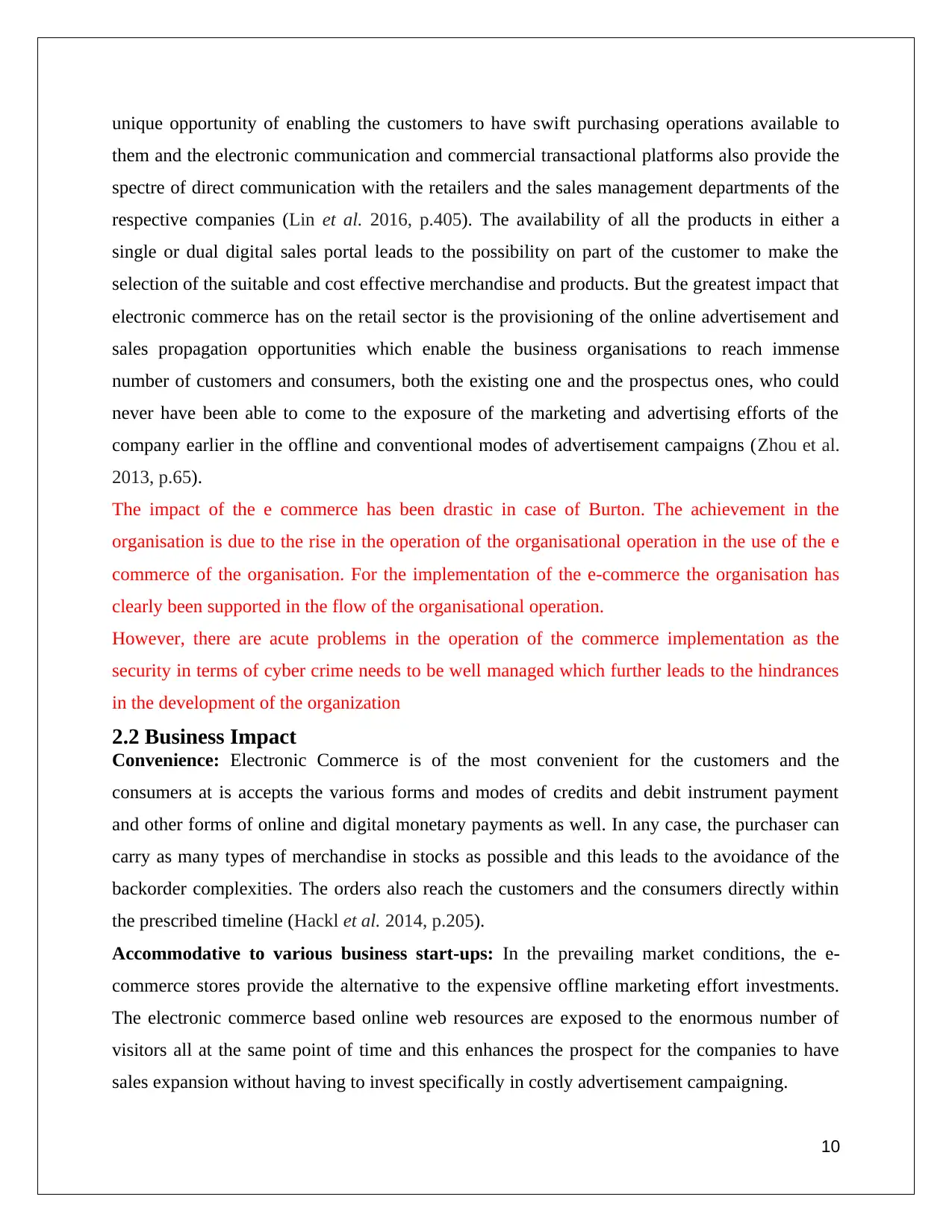
unique opportunity of enabling the customers to have swift purchasing operations available to
them and the electronic communication and commercial transactional platforms also provide the
spectre of direct communication with the retailers and the sales management departments of the
respective companies (Lin et al. 2016, p.405). The availability of all the products in either a
single or dual digital sales portal leads to the possibility on part of the customer to make the
selection of the suitable and cost effective merchandise and products. But the greatest impact that
electronic commerce has on the retail sector is the provisioning of the online advertisement and
sales propagation opportunities which enable the business organisations to reach immense
number of customers and consumers, both the existing one and the prospectus ones, who could
never have been able to come to the exposure of the marketing and advertising efforts of the
company earlier in the offline and conventional modes of advertisement campaigns (Zhou et al.
2013, p.65).
The impact of the e commerce has been drastic in case of Burton. The achievement in the
organisation is due to the rise in the operation of the organisational operation in the use of the e
commerce of the organisation. For the implementation of the e-commerce the organisation has
clearly been supported in the flow of the organisational operation.
However, there are acute problems in the operation of the commerce implementation as the
security in terms of cyber crime needs to be well managed which further leads to the hindrances
in the development of the organization
2.2 Business Impact
Convenience: Electronic Commerce is of the most convenient for the customers and the
consumers at is accepts the various forms and modes of credits and debit instrument payment
and other forms of online and digital monetary payments as well. In any case, the purchaser can
carry as many types of merchandise in stocks as possible and this leads to the avoidance of the
backorder complexities. The orders also reach the customers and the consumers directly within
the prescribed timeline (Hackl et al. 2014, p.205).
Accommodative to various business start-ups: In the prevailing market conditions, the e-
commerce stores provide the alternative to the expensive offline marketing effort investments.
The electronic commerce based online web resources are exposed to the enormous number of
visitors all at the same point of time and this enhances the prospect for the companies to have
sales expansion without having to invest specifically in costly advertisement campaigning.
10
them and the electronic communication and commercial transactional platforms also provide the
spectre of direct communication with the retailers and the sales management departments of the
respective companies (Lin et al. 2016, p.405). The availability of all the products in either a
single or dual digital sales portal leads to the possibility on part of the customer to make the
selection of the suitable and cost effective merchandise and products. But the greatest impact that
electronic commerce has on the retail sector is the provisioning of the online advertisement and
sales propagation opportunities which enable the business organisations to reach immense
number of customers and consumers, both the existing one and the prospectus ones, who could
never have been able to come to the exposure of the marketing and advertising efforts of the
company earlier in the offline and conventional modes of advertisement campaigns (Zhou et al.
2013, p.65).
The impact of the e commerce has been drastic in case of Burton. The achievement in the
organisation is due to the rise in the operation of the organisational operation in the use of the e
commerce of the organisation. For the implementation of the e-commerce the organisation has
clearly been supported in the flow of the organisational operation.
However, there are acute problems in the operation of the commerce implementation as the
security in terms of cyber crime needs to be well managed which further leads to the hindrances
in the development of the organization
2.2 Business Impact
Convenience: Electronic Commerce is of the most convenient for the customers and the
consumers at is accepts the various forms and modes of credits and debit instrument payment
and other forms of online and digital monetary payments as well. In any case, the purchaser can
carry as many types of merchandise in stocks as possible and this leads to the avoidance of the
backorder complexities. The orders also reach the customers and the consumers directly within
the prescribed timeline (Hackl et al. 2014, p.205).
Accommodative to various business start-ups: In the prevailing market conditions, the e-
commerce stores provide the alternative to the expensive offline marketing effort investments.
The electronic commerce based online web resources are exposed to the enormous number of
visitors all at the same point of time and this enhances the prospect for the companies to have
sales expansion without having to invest specifically in costly advertisement campaigning.
10
Paraphrase This Document
Need a fresh take? Get an instant paraphrase of this document with our AI Paraphraser
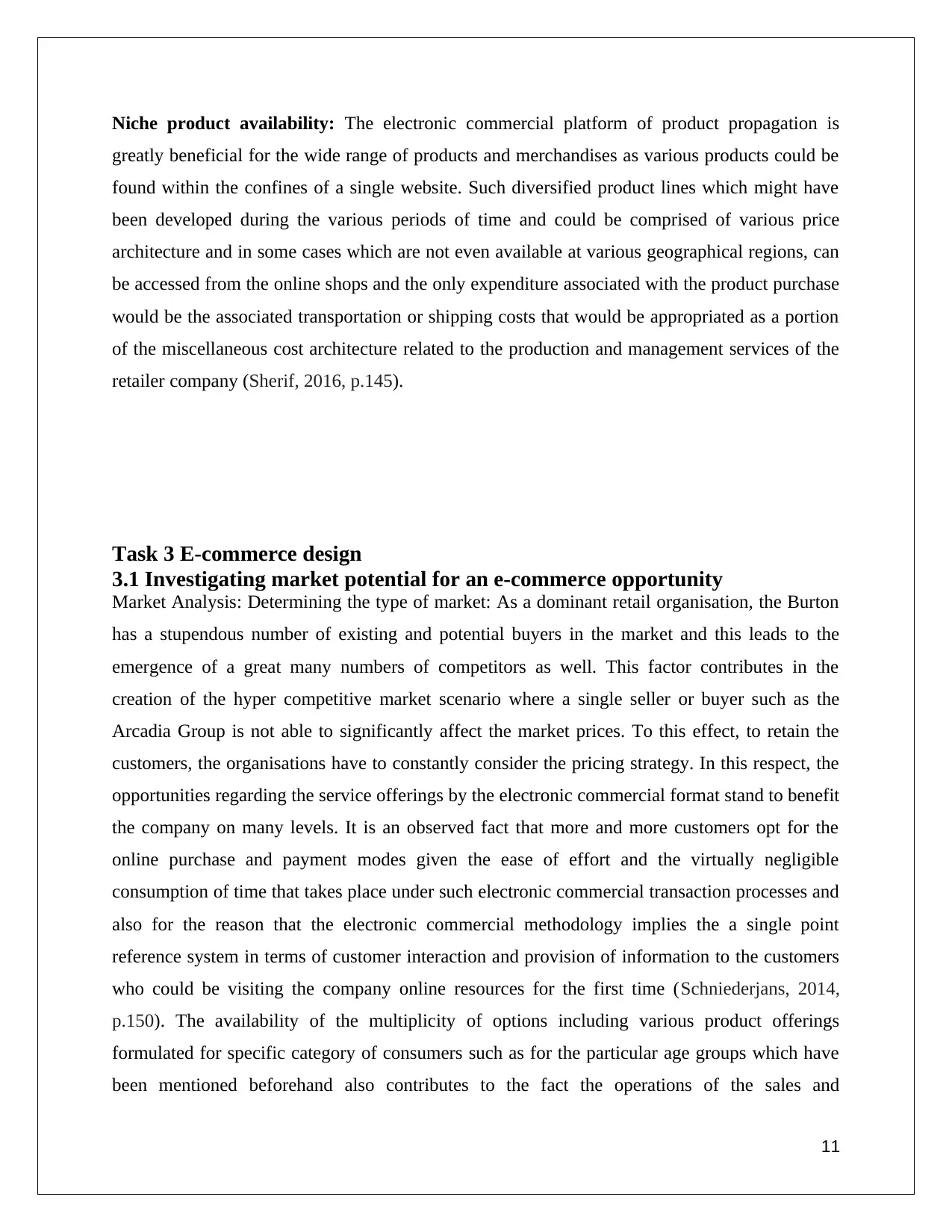
Niche product availability: The electronic commercial platform of product propagation is
greatly beneficial for the wide range of products and merchandises as various products could be
found within the confines of a single website. Such diversified product lines which might have
been developed during the various periods of time and could be comprised of various price
architecture and in some cases which are not even available at various geographical regions, can
be accessed from the online shops and the only expenditure associated with the product purchase
would be the associated transportation or shipping costs that would be appropriated as a portion
of the miscellaneous cost architecture related to the production and management services of the
retailer company (Sherif, 2016, p.145).
Task 3 E-commerce design
3.1 Investigating market potential for an e-commerce opportunity
Market Analysis: Determining the type of market: As a dominant retail organisation, the Burton
has a stupendous number of existing and potential buyers in the market and this leads to the
emergence of a great many numbers of competitors as well. This factor contributes in the
creation of the hyper competitive market scenario where a single seller or buyer such as the
Arcadia Group is not able to significantly affect the market prices. To this effect, to retain the
customers, the organisations have to constantly consider the pricing strategy. In this respect, the
opportunities regarding the service offerings by the electronic commercial format stand to benefit
the company on many levels. It is an observed fact that more and more customers opt for the
online purchase and payment modes given the ease of effort and the virtually negligible
consumption of time that takes place under such electronic commercial transaction processes and
also for the reason that the electronic commercial methodology implies the a single point
reference system in terms of customer interaction and provision of information to the customers
who could be visiting the company online resources for the first time (Schniederjans, 2014,
p.150). The availability of the multiplicity of options including various product offerings
formulated for specific category of consumers such as for the particular age groups which have
been mentioned beforehand also contributes to the fact the operations of the sales and
11
greatly beneficial for the wide range of products and merchandises as various products could be
found within the confines of a single website. Such diversified product lines which might have
been developed during the various periods of time and could be comprised of various price
architecture and in some cases which are not even available at various geographical regions, can
be accessed from the online shops and the only expenditure associated with the product purchase
would be the associated transportation or shipping costs that would be appropriated as a portion
of the miscellaneous cost architecture related to the production and management services of the
retailer company (Sherif, 2016, p.145).
Task 3 E-commerce design
3.1 Investigating market potential for an e-commerce opportunity
Market Analysis: Determining the type of market: As a dominant retail organisation, the Burton
has a stupendous number of existing and potential buyers in the market and this leads to the
emergence of a great many numbers of competitors as well. This factor contributes in the
creation of the hyper competitive market scenario where a single seller or buyer such as the
Arcadia Group is not able to significantly affect the market prices. To this effect, to retain the
customers, the organisations have to constantly consider the pricing strategy. In this respect, the
opportunities regarding the service offerings by the electronic commercial format stand to benefit
the company on many levels. It is an observed fact that more and more customers opt for the
online purchase and payment modes given the ease of effort and the virtually negligible
consumption of time that takes place under such electronic commercial transaction processes and
also for the reason that the electronic commercial methodology implies the a single point
reference system in terms of customer interaction and provision of information to the customers
who could be visiting the company online resources for the first time (Schniederjans, 2014,
p.150). The availability of the multiplicity of options including various product offerings
formulated for specific category of consumers such as for the particular age groups which have
been mentioned beforehand also contributes to the fact the operations of the sales and
11
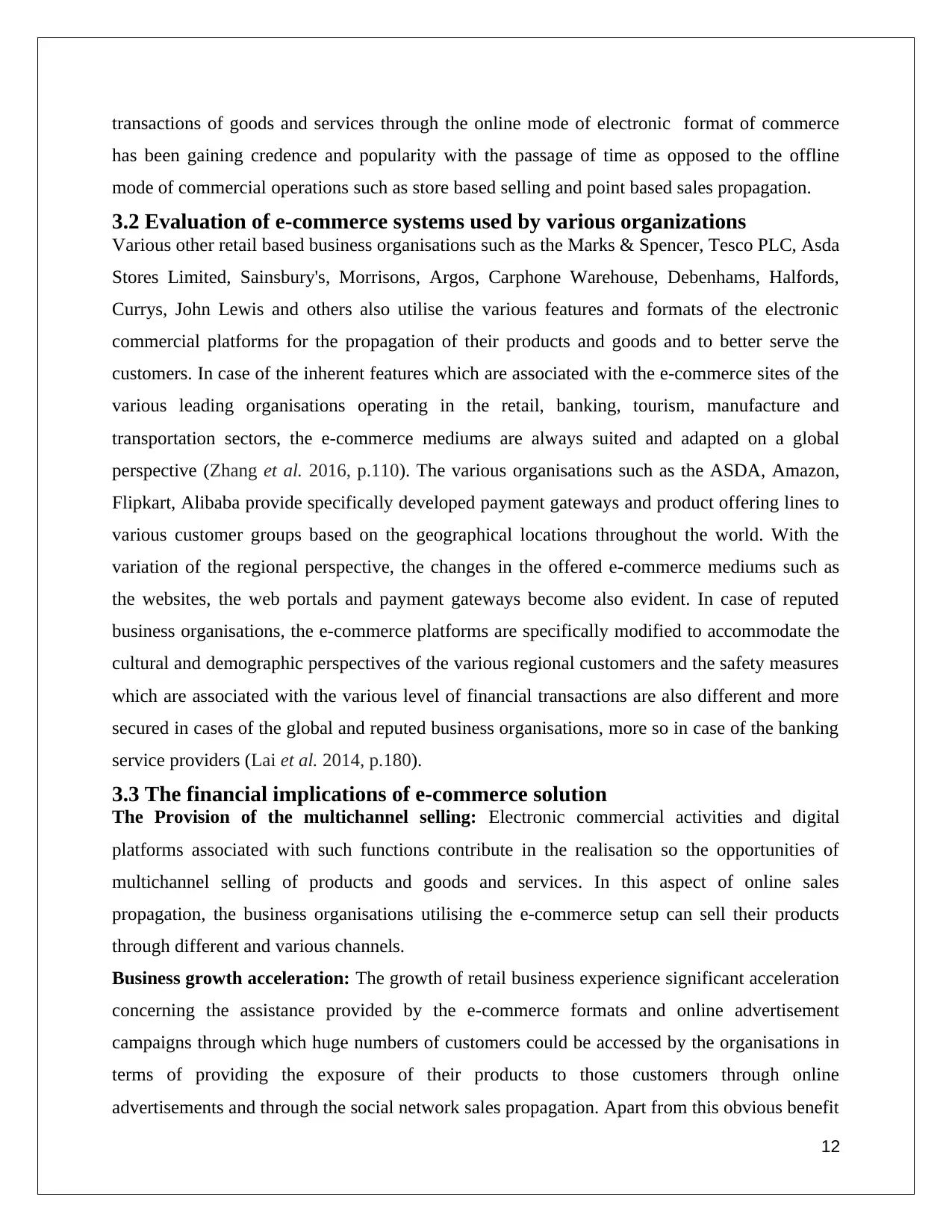
transactions of goods and services through the online mode of electronic format of commerce
has been gaining credence and popularity with the passage of time as opposed to the offline
mode of commercial operations such as store based selling and point based sales propagation.
3.2 Evaluation of e-commerce systems used by various organizations
Various other retail based business organisations such as the Marks & Spencer, Tesco PLC, Asda
Stores Limited, Sainsbury's, Morrisons, Argos, Carphone Warehouse, Debenhams, Halfords,
Currys, John Lewis and others also utilise the various features and formats of the electronic
commercial platforms for the propagation of their products and goods and to better serve the
customers. In case of the inherent features which are associated with the e-commerce sites of the
various leading organisations operating in the retail, banking, tourism, manufacture and
transportation sectors, the e-commerce mediums are always suited and adapted on a global
perspective (Zhang et al. 2016, p.110). The various organisations such as the ASDA, Amazon,
Flipkart, Alibaba provide specifically developed payment gateways and product offering lines to
various customer groups based on the geographical locations throughout the world. With the
variation of the regional perspective, the changes in the offered e-commerce mediums such as
the websites, the web portals and payment gateways become also evident. In case of reputed
business organisations, the e-commerce platforms are specifically modified to accommodate the
cultural and demographic perspectives of the various regional customers and the safety measures
which are associated with the various level of financial transactions are also different and more
secured in cases of the global and reputed business organisations, more so in case of the banking
service providers (Lai et al. 2014, p.180).
3.3 The financial implications of e-commerce solution
The Provision of the multichannel selling: Electronic commercial activities and digital
platforms associated with such functions contribute in the realisation so the opportunities of
multichannel selling of products and goods and services. In this aspect of online sales
propagation, the business organisations utilising the e-commerce setup can sell their products
through different and various channels.
Business growth acceleration: The growth of retail business experience significant acceleration
concerning the assistance provided by the e-commerce formats and online advertisement
campaigns through which huge numbers of customers could be accessed by the organisations in
terms of providing the exposure of their products to those customers through online
advertisements and through the social network sales propagation. Apart from this obvious benefit
12
has been gaining credence and popularity with the passage of time as opposed to the offline
mode of commercial operations such as store based selling and point based sales propagation.
3.2 Evaluation of e-commerce systems used by various organizations
Various other retail based business organisations such as the Marks & Spencer, Tesco PLC, Asda
Stores Limited, Sainsbury's, Morrisons, Argos, Carphone Warehouse, Debenhams, Halfords,
Currys, John Lewis and others also utilise the various features and formats of the electronic
commercial platforms for the propagation of their products and goods and to better serve the
customers. In case of the inherent features which are associated with the e-commerce sites of the
various leading organisations operating in the retail, banking, tourism, manufacture and
transportation sectors, the e-commerce mediums are always suited and adapted on a global
perspective (Zhang et al. 2016, p.110). The various organisations such as the ASDA, Amazon,
Flipkart, Alibaba provide specifically developed payment gateways and product offering lines to
various customer groups based on the geographical locations throughout the world. With the
variation of the regional perspective, the changes in the offered e-commerce mediums such as
the websites, the web portals and payment gateways become also evident. In case of reputed
business organisations, the e-commerce platforms are specifically modified to accommodate the
cultural and demographic perspectives of the various regional customers and the safety measures
which are associated with the various level of financial transactions are also different and more
secured in cases of the global and reputed business organisations, more so in case of the banking
service providers (Lai et al. 2014, p.180).
3.3 The financial implications of e-commerce solution
The Provision of the multichannel selling: Electronic commercial activities and digital
platforms associated with such functions contribute in the realisation so the opportunities of
multichannel selling of products and goods and services. In this aspect of online sales
propagation, the business organisations utilising the e-commerce setup can sell their products
through different and various channels.
Business growth acceleration: The growth of retail business experience significant acceleration
concerning the assistance provided by the e-commerce formats and online advertisement
campaigns through which huge numbers of customers could be accessed by the organisations in
terms of providing the exposure of their products to those customers through online
advertisements and through the social network sales propagation. Apart from this obvious benefit
12
⊘ This is a preview!⊘
Do you want full access?
Subscribe today to unlock all pages.

Trusted by 1+ million students worldwide
1 out of 21
Related Documents
Your All-in-One AI-Powered Toolkit for Academic Success.
+13062052269
info@desklib.com
Available 24*7 on WhatsApp / Email
![[object Object]](/_next/static/media/star-bottom.7253800d.svg)
Unlock your academic potential
Copyright © 2020–2025 A2Z Services. All Rights Reserved. Developed and managed by ZUCOL.





